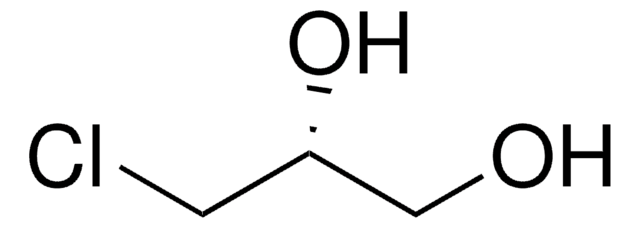Wichtige Dokumente
Y0001048
Levodropropizin Unreinheit C
European Pharmacopoeia (EP) Reference Standard
Synonym(e):
(±)-Glycidol, (±)-Oxiran-2-methanol, 2,3-Epoxy-1-propanol, Glyceringlycide
About This Item
Empfohlene Produkte
Qualität
pharmaceutical primary standard
Dampfdichte
2.15 (vs air)
Dampfdruck
0.9 mmHg ( 25 °C)
API-Familie
levodropropizine
Selbstzündungstemp.
780 °F
Hersteller/Markenname
EDQM
Brechungsindex
n20/D 1.433 (lit.)
bp
61-62 °C/15 mmHg (lit.)
Dichte
1.117 g/mL at 25 °C (lit.)
Anwendung(en)
pharmaceutical (small molecule)
Format
neat
Lagertemp.
−20°C
SMILES String
OCC1CO1
InChI
1S/C3H6O2/c4-1-3-2-5-3/h3-4H,1-2H2
InChIKey
CTKINSOISVBQLD-UHFFFAOYSA-N
Suchen Sie nach ähnlichen Produkten? Aufrufen Leitfaden zum Produktvergleich
Allgemeine Beschreibung
Anwendung
Verpackung
Sonstige Hinweise
Ähnliches Produkt
Signalwort
Danger
Gefahreneinstufungen
Acute Tox. 2 Inhalation - Acute Tox. 4 Dermal - Acute Tox. 4 Oral - Carc. 1B - Eye Irrit. 2 - Muta. 2 - Repr. 1B - Skin Irrit. 2 - STOT SE 3
Zielorgane
Respiratory system
Lagerklassenschlüssel
6.1A - Combustible acute toxic Cat. 1 and 2 / very toxic hazardous materials
WGK
WGK 3
Flammpunkt (°F)
161.6 °F
Flammpunkt (°C)
72 °C
Hier finden Sie alle aktuellen Versionen:
Analysenzertifikate (COA)
Leider sind derzeit keine COAs für dieses Produkt online verfügbar.
Wenn Sie Hilfe benötigen, wenden Sie sich bitte an Kundensupport
Besitzen Sie dieses Produkt bereits?
In der Dokumentenbibliothek finden Sie die Dokumentation zu den Produkten, die Sie kürzlich erworben haben.
Unser Team von Wissenschaftlern verfügt über Erfahrung in allen Forschungsbereichen einschließlich Life Science, Materialwissenschaften, chemischer Synthese, Chromatographie, Analytik und vielen mehr..
Setzen Sie sich mit dem technischen Dienst in Verbindung.

